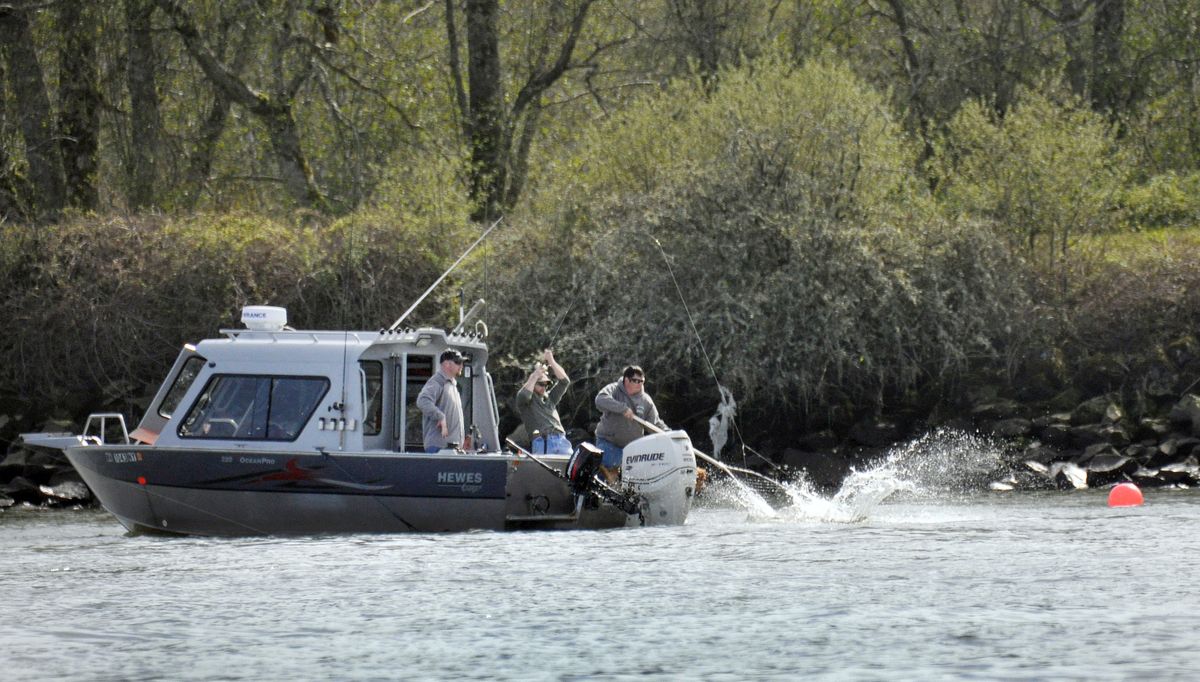Taking a shine to spring chinook
Anglers get head start on Columbia beauties

Inland Northwest spring chinook anglers tend to wait for the most oil-rich of salmon to come to them. Indeed, action during short upriver seasons can be frantic when water conditions allow, but anglers determined to get their fair share of the run have been traveling to lower Columbia River for the earlier fisheries.
Once again, fisheries managers from Washington and Oregon have allocated 75 percent of the total 2014 sportfishing harvest to fisheries below Bonneville, where there are more anglers.
Meanwhile, about 70 percent of spring chinook are bound for hatcheries above the dam, and most of those come from facilities on Idaho’s Salmon and Clearwater rivers.
Fisheries managers expect 308,000 spring chinook back to the mouth of the Columbia this year, and about 70 percent of those chrome-bright beauties are projected to swim over Bonneville.
An eye-popping 167,000 are projected to enter the Snake River, more than half the entire run of Columbia River spring chinook.
So why would anyone in the Inland Northwest ever need to leave the Snake River to catch spring chinook?
Anglers below Bonneville have already retained more fish in 2014 than mid-Columbia and Snake River anglers will be allowed to bonk all season, no matter how strong the run comes in. The entire preseason allocation afforded to Snake River anglers is a scant 950 fish, although the run will be updated eventually and increases in the quota are possible.
While the preseason allocation for the lower Columbia is a staggering 10,157, mid-Columbia anglers are only granted 1,354 fish.
This discrepancy in opportunity typifies the relationship between those below and above Bonneville, but as Portlanders chide and many upriver anglers have learned, everyone is welcome to come fish the lower Columbia.
Spring chinook tend to enter the lower river in large numbers well before moving into the Columbia Gorge and haven’t been showing up to the Inland Northwest in good numbers until late April or early May in recent years.
Fishing heats up downstream long before traffic gets busy in the fish ladder at Bonneville, and fish are caught every year beginning in February.
More frequent catches occur throughout March and into April, when the bulk of the run typically starts to arrive in the lower river.
Late March and early April is a fine time to plan or book a trip for next spring, but opportunity still abounds in 2014 for fish fresh out of the ocean and for some new scenery. The lower river will reopen for springers in mid-May once fisheries managers perform a run update.
Water temperatures are typically ideal for an epic bite during a May reopener.
The flow of chrome fish into the lower river begins with springers and increases in intesity all summer with the arrival of steelhead and summer and fall chinook into the tidally influenced Columbia and its network of channels and big islands.
Clarkston’s Toby Wyatt of Reel-Time Fishing is one of many upriver guides who travels downstream to extend his fishing season and to get his clients into chrome-bright springers fresh out of the saltwater.
Wyatt calls another great springer river home: Idaho’s Clearwater. But rather than wait until enough springers reach Lewiston to offer good fishing, he hits the road to head off fish bound for Idaho.
“This year I spent two weeks down in Portland, and as usual it was well worth the trip,” said Wyatt. “The first week was spotty, but the second was absolutely on fire with limits.’
Idaho spring chinook are amazing fish, but they have two strikes against them from an impatient salmon addict’s perspective:
• They don’t show up in good numbers to the Gem State until May;
• Brighter, sea-lice covered fish are available closer to the ocean and earlier in the spring.
Sea lice are a harmless parasite that latch onto salmon bellies in saltwater and ride them to their dooms when the salmon return to fresh water. Sea lice on a Columbia River salmon are a good sign that the fish has just come from the salt and the meat is as firm and fresh as it can possibly be.
Wyatt jokingly warns of the dangers of what he calls “Chrome’s Disease,” a condition whereby an angler becomes addicted to only the chromey-est of fish, spurning all others.
“Early in the year our upriver springers (in Idaho) cut just as good as a fish from Portland, but there is something just so beautiful about a dime-bright fish just out of the ocean,” he said.
Most of his Wyatt’s clients follow him from upriver, and many follow him to his different fishing locales as he follows the best fishing up the system.
He begins in Portland and then books trips on Drano Lake, the mouth of the Wind River and the tailrace below John Day Dam.
Once enough fish are streaming over McNary Dam enroute to the Snake River and Ice Harbor Dam, he works his way up the Snake back to his home in the Lewis and Clark Valley. He ends his season in early June on the Clearwater.
It takes a little while for the springers to get there, but Idaho’s prospects look very good this year, with approximately 5,000 fish available to sport anglers on the Clearwater River and another 10,000 potentially available on the Salmon River, according to Idaho Department of Fish and Game fish biologist Sam Sparr.
Idaho spring chinook swim a long way – 465 miles from the ocean – just to reach the confluence of the Clearwater and the Snake. But their flesh is still in fine condition when they arrive and it stays in great shape into June.